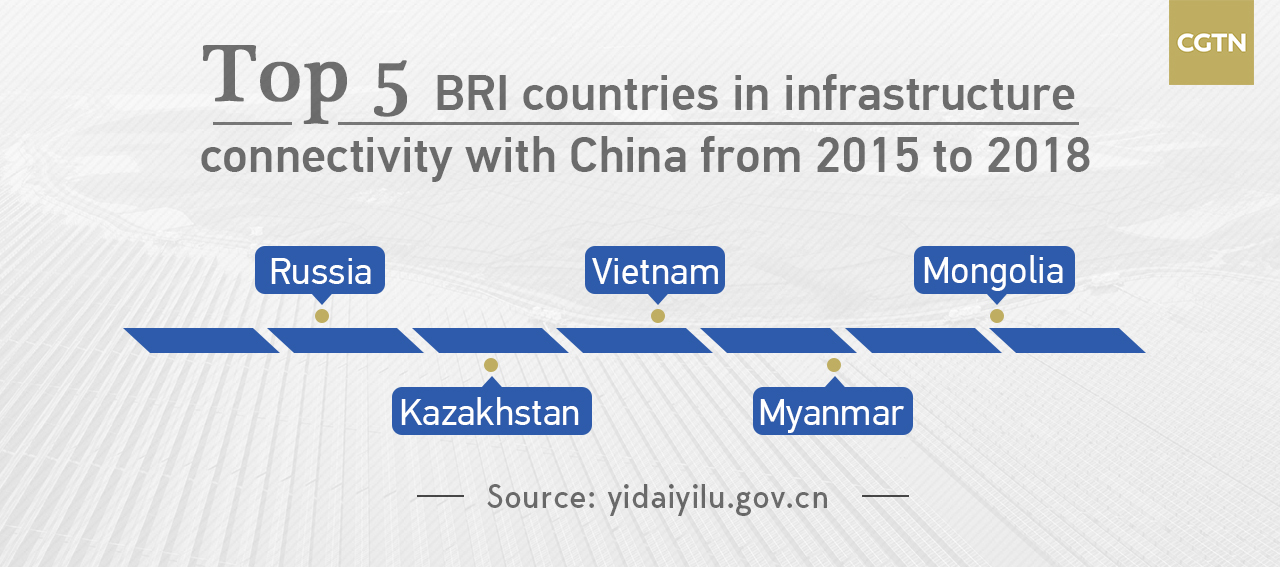
Money Stories
14:55, 22-Apr-2019
Data Tells: BRI infrastructures boost connectivity
Zhang Xinyuan

Proposed by Chinese President Xi Jinping back in 2013, Belt and Road
initiative (BRI) aims to boost trade exchanges, political understanding and
people-to people bonds between China and the rest of the world through reviving
the ancient trade routes along Asia, Europe and Africa.
To achieve the goal, one of the country's priorities is promoting the infrastructure connectivity between China and BRI countries, since it's the foundation of international cooperation and development.
China has made remarkable progress toward the goal.
According to the latest statistics by China's Ministry of Transport, until May 2017, China has signed more than 130 bilateral and regional transportation agreements with BRI countries, covering railways, roads and civil aviation. Direct flights now link China with 43 BRI countries.
According to the Ministry, 356 cross-border highway and railway routes had been opened between China and 15 BRI countries by the end of 2016.
Many iconic projects have been accomplished ever since 2013 through the cooperation between China and BRI cooperation.
After 33 months of construction, The China-Maldives Friendship Bridge, the first cross-sea bridge in the Maldives, went into operation in August 2018.
Connecting capital Male and neighboring Hulhule island where the Maldives' main international airport is located, the two-km bridge makes it possible for locals and tourists to transfer between the two islands on land within five minutes.

CGTN infographics
CGTN infographics
In July 2018, the fourth bridge over the Panama Canal is to begin construction. The 6.5-kilometer bridge will have six car lanes and a two-way metro line.
Saudi Arabia in September last year has opened a 450km high-speed Haramain Railway constructed by Chinese companies, to connect the holy cities of Mecca and Medina with Jeddah and King Abdullah Economic City. The railway line is expected to transport 60 million passengers a year.
Besides transportation, President Xi also proposed further joint cooperation on telecommunication, green energy, and concentrate the efforts on key passageways, cities and projects.
By the end of last year, China finished the Beidou satellite system deployment and started to provide the basic navigation service to BRI countries.
After three and a half years of efforts by China Telecom and Nepal Telecom, the Internet cable between China and Nepal finally launched into service, which could significantly improve the Internet service level of Nepal.
China and BRI countries also made great efforts in developing green energy. April last year, the Neelum–Jhelum Hydropower Plant in Pakistan was synchronized with the national grid, the plant will generate 5,150 gigawatts per year for 30 years.
In terms of the key cities projects, the water supply and sewage treatment projects have finished by August last year in Kurunegala, Sri Lanka. The projects can provide safe drinking water to 71,000 local people and the sewage disposal is up to international standard.
China's efforts in improving the infrastructures in BRI countries has been widely recognized by international experts, believing it could promote connectivity and boost economic growth along the BRI countries.
Countries along the Belt and Road have long been troubled by poor infrastructure and a lack of investment. These countries can use this opportunity to upgrade their infrastructure and boost economic growth, said Sergey Lukonin, head of the Sector of Chinese Economy and Politics, Center for Asian Pacific Studies, Primakov National Research Institute of World Economy and International Relations, in an interview with Xinhua in May 2017.
Graphics: Yin Yating

SITEMAP
Copyright © 2018 CGTN. Beijing ICP prepared NO.16065310-3
Copyright © 2018 CGTN. Beijing ICP prepared NO.16065310-3